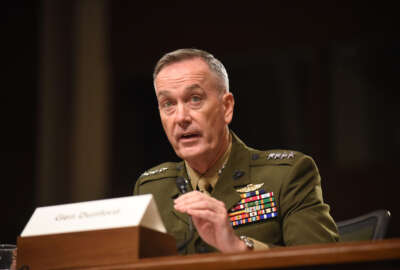
Secretary Carter unveils wide array of Defense reforms
Defense Secretary Ash Carter revealed a handful of reforms aimed at bringing the Defense Department into the 21st century.
Defense Secretary Ash Carter unveiled a set of defense reforms ranging from acquisition to personnel issues, which he says will bring the Defense Department into the future.
The reforms are billed as a sequel to the 30-year-old Goldwater-Nichols Act, which overhauled the DoD structure.
“We can see that the world has changed — instead of the Cold War and one clear threat, we face a security environment that’s dramatically different from the last quarter-century. It’s time that we consider practical updates to this critical organizational framework, while still preserving its spirit and intent,” Carter said during an April 5 speech at the Center for Strategic and International Studies in Washington.
The Pentagon will need congressional approval for some of the reforms he is suggesting.
The Pentagon is hoping the Armed Services Committees will fold Carter’s recommendations into the 2017 defense authorization bill, which is expected to come out this month.
But DoD has already taken action within the department to update policies within its executive authority, Carter said.
Since last fall, DoD has tried to simplify its headquarters. It mandated a 25 percent cut in headquarters staff, which includes the Office of the Secretary of Defense, the combatant commands and the Joint Staff. Carter said in the coming weeks the Pentagon will try to simplify its command structure by replacing four-star generals and admirals with three-star level personnel in billets where the department sees fit.
“[We] will look to simplify and improve command and control where the number of four-star positions have made headquarters either top-heavy, or less efficient than they could be,” Carter said. “The military is based on rank hierarchy, where juniors are subordinate in rank to their seniors. This is true from the platoon to the corps level, but it gets complicated at some of our combatant and component command headquarters.”
Carter added that in order to accommodate the reduction in headquarters staff functions like logistics, intelligence and plans will be integrated into the combatant commands and Joint Staff. That way the department can avoid consolidating its geographic commands — for instance merging U.S. Northern Command and U.S. Southern Command.
The extra work on the Joint Staff leads into another reform Carter has already harped on in congressional hearings: an expanded role for the Joint Chiefs of Staff. Carter wants lawmakers to make the role the Joint Chiefs are currently playing for him more formal.
The expanded role of the Joint Chiefs of Staff is rooted in DoD’s need to act on threats that move between regions and domains, since the combatant commands have geographic areas of responsibility they are restricted in that way.
“I would like to strengthen the role of the Joint Chiefs of Staff and the chairman,” Carter told lawmakers in March. “Because different [combatant commands] see different things in their regions, they are all deeply expert in their own regions, but somebody needs to put it all together and give me advice about that: how to synchronize all those forces.”
Carter said he needs the Joint Chiefs to act as a parent to the commands when they are all demanding resources.
“Each individual [combatant command] naturally has a tendency to say ‘I need it all, I desperately need it all’ and that’s human nature and that’s what you want… But we don’t have an infinite amount of stuff and so there needs to be a global integrator,” Carter said. “[The law] doesn’t say [the Chairman of the Joint Chiefs of Staff] is supposed to be giving me the advice on where things ought to be and how they ought to be used … Everybody knows that I look to [Chairman] Joe Dunford to do that, but I think it’s worth writing it down because there will be others who come along later and it’s important to clarify that is a requirement.”
Last month, Dunford said putting those responsibilities into law would not require more staff on his part, mostly because the Joint Staff is trying to slim down in other areas.
Another reform that will require congressional approval deals with streamlining the acquisition process.
Carter called for cutting the number of members on the Defense Acquisition Board. The DAB is the senior advisory board for the DoD acquisition system and provides advice on acquisition decisions. It currently has 35 members.
Each member is “likely to feel empowered as a gatekeeper for acquisition; reducing these layers will both free up staff time and focus decision-making energy on overcoming real obstacles to program success rather than bureaucratic hurdles,” Carter said.
He added DoD wants to reduce the amount of paperwork involved in acquisition. The 2016 defense authorization act took some of the paperwork burden off of program managers.
The chairmen of both Armed Services Committees have been big proponents of acquisition reform. Last year’s bill also gave military service chiefs more of a say in the acquisition process.
Carter’s proposals also push ahead on his Force of the Future personnel reforms. Carter suggested changing the requirements for joint duty assignments, which are “more narrow and rigid than they need to be.”
Officers looking to move to higher ranks of the military are required to engage in joint duty.
“While a staff officer in a combatant command would get joint duty credit, an officer in a combined air operations center coordinating with service members in all different uniforms to call in airstrikes against ISIL might not. In another case, take two cyber airmen working at a combatant command – one does cyber plans and gets joint credit, the other does cyber targeting and doesn’t,” Carter said.
Carter’s reforms would try to fix those discrepancies.
Copyright © 2024 Federal News Network. All rights reserved. This website is not intended for users located within the European Economic Area.
Scott Maucione is a defense reporter for Federal News Network and reports on human capital, workforce and the Defense Department at-large.
Follow @smaucioneWFED




